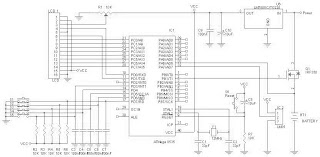ADC 207 is the first to use Flash Converting An Advanced High Speed VLSI 1.2 micron CMOS process. The process that is able to do the ADC 207 as mentioned earlier is very great and makes the ADC 207 is unique. The speed of the process of this ADC has a good linearity and have a stable temperature. ADC 207 has a lower power consumption is 250 mW. ADC is working with +5 VDC voltage source and at a frequency of 20 MHz. ADC 207 has a small sampling time is 12nS, thus making the ideal sampling results. ADC 207 has 128 features auto balanced comparators with each conversion that serves to offset temperature and dynamic effects that exist. Resistor ladder in the ADC 207 has a mid point that is connected to an external voltage source and function in the conversion of 7-bit linearity. ADC 207 has 3 levels of output that is easy to connect it with external components.
ADC 207 Architecture
Feature ADC 207
- 7-bit flash A / D Converter
- Sampling frequency of 20 MHz
- Low power consumption (250mW)
- VCC 5 VDC
- 1.2 micron CMOS technology
- 7 bits with 3 levels of output gates and overflow bits














